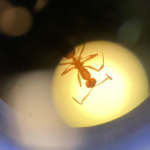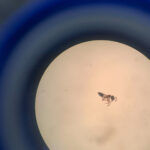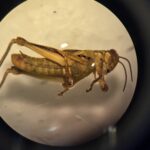Sample information |
|
| Picture |


|
|---|---|
| Location | |
| Collection date | 05/27/2025 |
| Captive / Cultivated? | Wild-caught |
| Group | Pingry School |
| Observations | Arthropod lives amongst dry leaves and sticks, crawls around. Arthropod has 4 wings, 2 long and 2 short, fur on the tail, lighter lines going across his black body. |
| Putative identification | Arthropoda Insecta Hymenoptera Formicidae Camponotus Camponotus pennsylvanicus |
Methods |
|
| Extraction kit | DNeasy (Qiagen) |
| DNA extraction location | Abdomen |
| Single or Duplex PCR | Single Reaction |
| Gel electrophoresis system | Standard electrophoresis system |
| Buffer | 1X TAE |
| DNA stain | SYBR Safe |
| Gel images |


|
| Protocol notes | DNA Extraction using DNeasy (Qiagen) Kit 1. Cell lysis and DNA precipitation 2. DNA purification using column chromatography 3. DNA Elution using AE buffer Checking DNA Extraction With Nanodrop – Arthropod DNA concentration: 50.8 ng/uL, 230 nm PCR using Taq Master Mix |
Results |
|
| Wolbachia presence | Yes |
| Confidence level | High |
| Explanation of confidence level | There is a band in the column of arthropod DNA. The controls — an arthropod with wolbachia, without wolbachia, and the positive wolbachia DNA — appeared in the arthropod gel, while negative DNA (distilled water) did not, showing that the gel worked. This means arthropod DNA extraction was successful. A band appeared for the sample arthropod’s wolbachia, indicating wolbachia is present in the arthropod. The controls all worked: the column with DNA of the bug with wolbachia had a band, the column with the DNA of a bug without wolbachia did not, positive wolbachia DNA has a band, and negative wolbachia DNA did not. This menas the gel accurately detected if wolbachia was present. The arthropod DNA size is between 500 and 1000 base pairs, which is what arthropod DNA should be (around 658 bp). The wolbachia DNA size is below 500, which is what wolbachia DNA typically is (438 bp). The quality of the gel is due to having too thin of a gel and running the gel too fast (120V). |
| Wolbachia 16S sequence | Download FASTA
Download AB1
GCTCGTGTCGTGAGATGTTGGGTTAAGTCCCGCAACGAGCGCAACCCTCATCCTTAGTTACCATCAGGTAATGCTGGGGACTTTAAGGAAACTGCCAGTGATAAACTGGAGGAAGGTGGGGATGATGTCAAGTCATCATGGCCCTTATGGAGTGGGCTACACACGTGCTACAATGGTGGCTATAATGGGCTGCAAAGTCGCGAGGCTAAGCTAATCCCTTAAAAGCCATCTCAGTTCGGATTGTACTCTGCAACTCGAGTGCATGAAGTTGGAATCGCTAGTAATCGTGGATCAGCACGCCACGGTGAATACGTTCTCGGGTCTTGTACACACTGCCCGTCACGCCATGGGAATTG
BLAST at The Wolbachia Project BLAST at NCBI
|
| Arthropod COI sequence | Download FASTA
Download AB1
CTCCTGATTCACTAATTCTTAATGATCAAACTTTCAATACCATCGTTACAAGTCATGCTTTTATTATAATTTTTTTTATA GTTATACCTTTTATAATTGGGGGATTTG
BLAST at The Wolbachia Project BLAST at NCBI
|
| Summary | The Camponotus pennsylvanicus was found to be postive for Wolbachia. |
 Formica Pallidefulva
Formica Pallidefulva Formica Pallidefulva
Formica Pallidefulva Ant
Ant Differential Grasshopper – Melanoplus differentialis
Differential Grasshopper – Melanoplus differentialis Pill Bug (Armadillidium vulgare) – Draft
Pill Bug (Armadillidium vulgare) – Draft